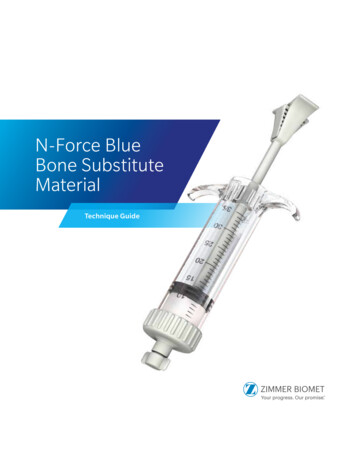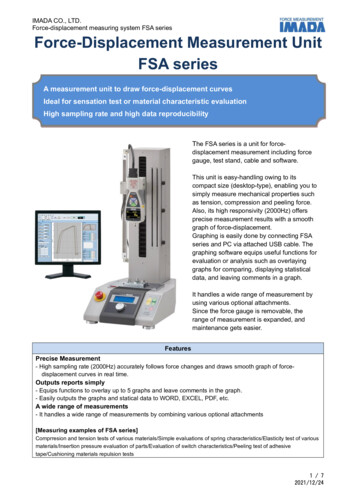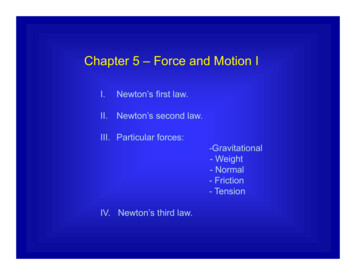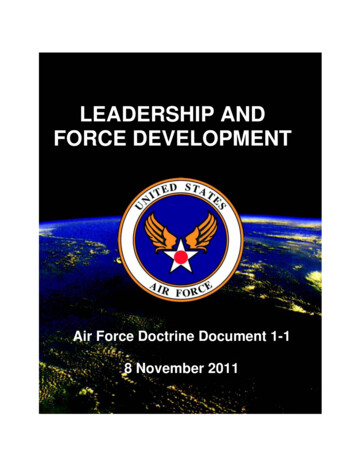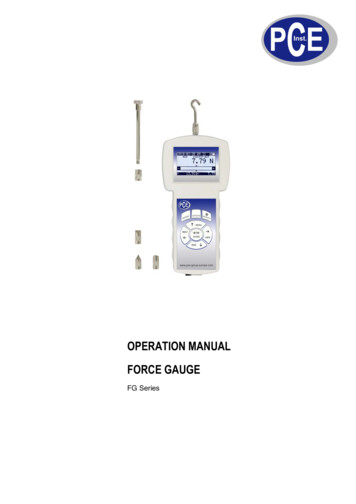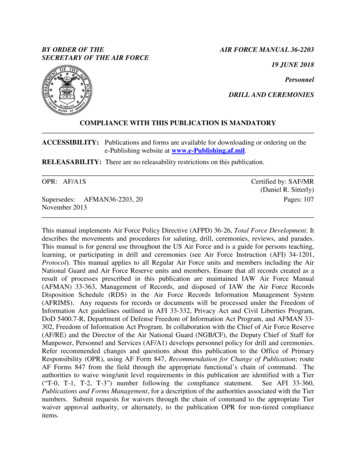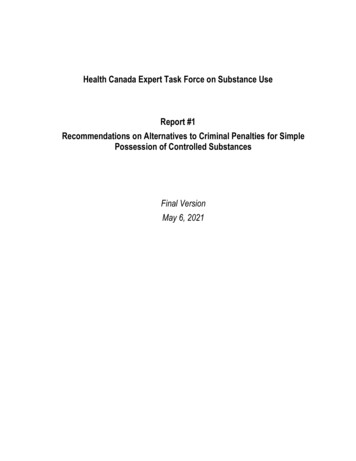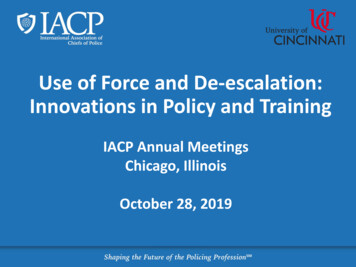
Transcription
Use of Force and De-escalation:Innovations in Policy and TrainingIACP Annual MeetingsChicago, IllinoisOctober 28, 2019
Panelists Robin S. Engel, PhD, Professor, University of Cincinnati;Director, IACP/UC Center for Police Research and Policy Chief Maris Herold, University of Cincinnati Police Division Deputy Chief Robert Schroeder, Louisville Metro PoliceDepartment Chief Todd Axtell, Saint Paul Police Department Michael D. White, PhD, Professor, Arizona State University
Reconsidering Police Use of ForceAftermath of controversial police shootings anduse of force in 2014 - 2015 National police-community relations crisis Protests and civil unrest “Ferguson effect”Photos: ix-its-police-force; ferguson/
The Call for De-escalation TrainingPresident’s Task Force on 21st Century Policing - 2015“Law enforcement agency policies for training on the use offorce should emphasize de-escalation and alternatives toarrest or summons in situations where appropriate.”“Recruit training must also include tactical and operationstraining on lethal and nonlethal use of force with an emphasison de-escalation and tactical retreat skills.”
Reconsidering Violence against Police July 2016 Dallas Police Officers: 5 killed, 9 woundedBaton Rouge Officers: 3 killed, 3 wounded Nationwide increase in ambush-style killings of policePrompted reconsideration of officer safety in “newconversations” about police use of lethal force
The Call for De-escalation Training PERF’s Guiding Principles on Use of Force - 201630 principles proposing substantial changes to police agencies’understanding and application of use of force and de-escalationalternatives National Consensus Policy & Discussion Paper, Use of Force –2017“An officer shall use de-escalation techniques and other alternativesto higher levels of force consistent with his or her training wheneverpossible and appropriate before resorting to force and to reduce theneed for force.”
De-escalation DefinedNational Consensus Policy on Use of Force (2017)“Taking action or communicating verbally or nonverbally during a potential force encounter in an attemptto stabilize the situation and reduce the immediacy ofthe threat so that more time, options, and resources canbe called upon to resolve the situation without the useof force or with a reduction in the force necessary”
De-escalation TrainingSUPPORTCONCERNS Viewed as “common sense”approach Vacuum of evidence regardingofficer safety Perceived as effective for CITand SWAT units Training contradicts traditionaltactics Used in other countries –considered “best practice” Believed to add potential risksto officer safety as officers maybecome hesitant to use force(1) Reducing frequency/severity ofofficer use of force(2) Reducing officer/citizen risk ofinjury/death
What Do We Know? Most LE trainings untested; deescalation is no different Support: theoretical propositions,testimonials, anecdotes, untestedpresumptions of “best practice” Ineffective or adverse outcomes? Life and death situations – greatcaution should be exercised, butpolice executives cannot wait
A Multi-Disciplinary Systematic ReviewLooking across fields for insight on application andeffectiveness of de-escalation training Criminal Justice Criminology Public Health Psychology Sociology Education BusinessSearch Process:– 99 Literature databases– 16 search terms39,314 records retrieved
DatabaseSearchResults39,314 “Hits”1,493 downloads78 potentially relevant43 ineligible35 eligible55 bibliographysearch90 final coding64 relevantevaluations
Study Inclusion Criteria (Un)Published empirical assessments of de-escalation trainingDe-escalation as primary focus of evaluated trainingAll research designs – quantitative and qualitativeIndividual- and aggregate-level analysesAttitudinal and behavioral outcomesEvaluations excluded if De-escalation only single component in larger trainingcurriculum Training designed for purpose other than prevention /management of violence, aggression, or similar behaviors
Characteristics of Eligible StudiesCharacteristicCategoryJournal Article (peer reviewed)Thesis/DissertationPublication TypeConference ProceedingsResearch in BriefDisciplinePolicing / Law EnforcementCriminal Justice / ationTechnologyn573130036194311
Characteristics of Eligible StudiesCharacteristicCategoryJournal Article (peer reviewed)Thesis/DissertationPublication TypeConference ProceedingsResearch in BriefDisciplinePolicing / Law EnforcementCriminal Justice / ationTechnologyn573130036194311
Characteristics of Eligible StudiesRESEARCH DESIGNDesignRandomized controlled trial# of Studies(n 64)*0Interrupted time series; quasi-experimental4Interrupted times series; no comparison13Pre/post-test; quasi-experimental15Pre/post-test; no comparisonCross-sectional; quasi-experimental254Cross-sectional; no comparison2Qualitative6*Note that numbers add to greater than 64 because some studies incorporate mixed methods
Characteristics of Eligible StudiesRESEARCH DESIGNDesignRandomized controlled trial# of Studies(n 64)*0Interrupted time series; quasi-experimental4Interrupted times series; no comparison13Pre/post-test; quasi-experimental15Pre/post-test; no comparisonCross-sectional; quasi-experimental254Cross-sectional; no comparison2Qualitative6*Note that numbers add to greater than 64 because some studies incorporate mixed methods
Maryland Systematic Methods ScaleFindingsLevelDefinition# of Studies5Random assignment of treatment and controlcondition to units04Measures of outcome before and after treatment inmultiple experimental and control groups;controlling for other variables that might influencethe outcome03Measures of outcome before and after treatment inexperimental and comparable control group32Temporal sequence between treatment andoutcome clearly observed or presence ofcomparison group without demonstratedcomparability to treatment group571Correlation between treatment and outcome at asingle point in time4
Maryland Systematic Methods ScaleFindingsLevelDefinition# of Studies5Random assignment of treatment and controlcondition to units04Measures of outcome before and after treatment inmultiple experimental and control groups;controlling for other variables that might influencethe outcome03Measures of outcome before and after treatment inexperimental and comparable control group32Temporal sequence between treatment andoutcome clearly observed or presence ofcomparison group without demonstratedcomparability to treatment group571Correlation between treatment and outcome at asingle point in time4
Summary of Findings64 de-escalation training evaluations identified Most studies appear in nursing and psychiatric fields,none in policing or criminal justice/criminology More examined self-reported outcomes (73%) than actualbehavioral outcomes (48%) Generally favorable findings More positive findings for self-reported outcomes compared toactual behavioral outcomes Weak research designs Wide variation in training concepts and content acrosstrainings
ConclusionDe-escalation training as a“promising” practice Some supporting evidence for effectiveness of de-escalationtraining in other disciplines, but Questionable quality of research designs Reliance on self-reports Considerable variation in training programs Limited evidence of long-term effects No studies in policing Unknown if unintended consequences Additional evidence is desperately needed
Panelists Robin S. Engel, PhD, Professor, University of Cincinnati; Director, IACP/UC Center for Police Research and Policy Chief Maris Herold, University of Cincinnati Police Division Deputy Chief Robert Schroeder, Louisville Metro Police Department Chief Todd Axtell, Saint Paul Police Department Michael D. White, PhD, Professor, Arizona State University
